 John Morris: His Latest Figments (3)
John Morris: His Latest Figments (3)
Per my previous posts, in his increasingly frantic and inept efforts to explain away the glaring discrepancies in the original fiction he spun regarding Robert Capa’s actions on D-Day and the resulting fate of his Omaha Beach negatives, as well as his attempts to elide the improbabilities in the far-fetched “new theory” of those events that he is cobbling together, John Morris, the former LIFE picture editor, keeps digging himself into an ever deeper hole.
The research conducted by myself and others, published in 2014 at this blog, has already forced Morris to change his tune drastically. He now acknowledges that Capa likely made no more than the ten surviving images on Omaha Beach, staying there no longer than the 30 minutes or less that those exposures required, and that therefore no additional negatives of the landing got damaged or lost in LIFE‘s London darkroom on the night of June 7, 1944.
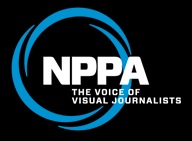 The latest round of these awkward, implausible rationales comes in a document Morris submitted to Bruce Young, a photographer and writer commissioned by the National Press Photographers Association (NPPA) to produce for the organization’s official journal what he describes as “a neutral piece accounting for everyone’s stories and claims.” Morris’s response to questions from Young take the form of a document he issued on January 5, 2015, titled “The A. D. Coleman Attack.” (Click here for a PDF.) Below I conclude my list of the untruths therein, each followed by the evidentiary disproofs thereof. — A. D. C.
The latest round of these awkward, implausible rationales comes in a document Morris submitted to Bruce Young, a photographer and writer commissioned by the National Press Photographers Association (NPPA) to produce for the organization’s official journal what he describes as “a neutral piece accounting for everyone’s stories and claims.” Morris’s response to questions from Young take the form of a document he issued on January 5, 2015, titled “The A. D. Coleman Attack.” (Click here for a PDF.) Below I conclude my list of the untruths therein, each followed by the evidentiary disproofs thereof. — A. D. C.
•
John Morris Figment 7: Morris writes, “On the basis of two visits to ICP [Coleman] assumes that three of the rolls which ICP holds in the Capa Archive — three rolls of the initial channel crossing — are the three rolls which I discarded as useless on the night of June 7, because there was nothing on them.” Supporting evidence: None.
Fact: This sentence appears deliberately constructed to mislead. I proposed, precisely, that Morris never discarded any blank 35mm films that night, because no blank films arrived. Instead, I suggested that Capa’s rolls of pre-invasion 35mm images arrived bundled with Capa’s one partial roll of Omaha Beach exposures and all his pre- and post-Omaha Beach exposures in all formats, in one single shipment, all of which got successfully developed in LIFE‘s London darkroom on the night of June 7, 1944 via standard processing. Nothing “ruined,” nothing “saved,” nothing “lost,” and thus nothing to “discard.”
John Morris Figment 8: Regarding his November 11, 2014 CNN interview, Morris writes, “[Coleman] finds an important new target: Christiane Amanpour of CNN. … [In the interview] We spoke about the new book of my photos taken in wartime Normandy and Brittany in 1944, Quelque Part en France. Then we spoke of D-Day, whose 70th anniversary we had both covered, and I told my oft-repeated story of the London darkroom disaster. She replied, ‘It still makes me sick to my stomach to think that evidence may have been lost forever.'” Supporting evidence: None.
Fact: The only bones I have picked with Amanpour concern her gullibility in relation to her old chum Morris and her failure as a journalist to follow up on his recantation of key portions of his rapidly collapsing standard narrative — that “oft-repeated story of the London darkroom disaster.”
The mention of Morris’s book and show comes not before, as he states, but immediately after his announcement — forced by the investigation conducted here — that Capa may have made no more than the ten negatives we have of the landing on Omaha Beach, and that therefore no D-Day negatives were destroyed in LIFE‘s London darkroom on the night of June 7, 1944.
The discussion thereof doesn’t come as an afterthought in this CNN interview, as Morris implies; it’s the very heart of Amanpour’s November 11 broadcast, and, from a news standpoint, the only raison d’être for the interview. (His little book of Normandy snapshots hardly warrants CNN’s coverage.)
The headline on this story at the CNN site reinforces that conclusion; it reads, “Robert Capa’s ‘lost’ D-Day photos may never have been shot at all, says his former editor.” Amanpour’s Facebook post earlier that day inviting her followers to watch that interview does the same; it reads, “Breaking Photo news! Capa’s ‘lost’ D-Day images may never have been shot at all. Listen to what his editor tells me.” Hence my surprise and disappointment that Amanpour asked Morris not one single follow-up question on that subject.
•
Notably, Morris makes no mention in the Amanpour interview of that immaculately conceived “advance packet.” Nor did he mention it in the summer 2014 interview published last October in Black & White magazine. Thus his recovered memory of that delivery comes from sometime between November 11 and January 5, the date of his response to the NPPA.
Now here’s a remarkable coincidence: In a post published here on November 30 — roughly halfway between his Amanpour appearance and the issuance of his response to the NPPA’s reporter — I wrote the following about an October 24 email Morris sent to me:
“Morris acknowledges familiarity with the four rolls of pre-invasion 35mm film, at the same time providing no indication that he’d received a prior shipment of pre-invasion films from Capa.”
In that same post, I published a November 1 email to Morris, in which I wrote,
“The problem I have here involves fitting those 4 rolls of pre-invasion film into the timeline. Capa certainly wouldn’t have held them back and sent them to you on June 8th or thereafter, once he’d returned to Normandy; by then they’d be old news. He couldn’t have sent them to you before he left the Chase and headed to Omaha Beach, because you’d certainly have mentioned receiving a preliminary shipment from him in your various accounts.”
Morris refused to answer that email. But five weeks later, by gum, here’s that indication. In other words, I baited the hook, and Morris et al. swallowed it. As I wrote further on in that post, “Fascinating revisionism here, with Morris doing what in science they call ‘saving the appearances’: trying feverishly to patch the holes in a paradigm or narrative that’s starting to leak like a sieve.”
John Morris Figment 9: In his January 5, 2015 response to the NPPA Morris reasserts that, when he examined the supposedly “ruined” rolls of Capa’s D-Day negatives, “there was nothing on the first three rolls. It was just pea soup.” (Old habits die hard.) But he follows that immediately with “the new theory,” to wit:
I think another explanation is also possible, that in the confusion of battle Capa simply got his rolls of 35 mixed up, but knew that he had shot at least those 11 frames. To insure that he had the right roll he bundled all four rolls of 35 into the one packet he gave to Dave Scherman at Weymouth for shipment to London and wisely wrote that note to me saying: “all the action is in the 4 rolls of 35 mm.”
That’s the very latest iteration of “the new theory.” Evidently it’s a work in progress. Here’s the earliest enunciation of it, from Black & White magazine (October 2014):
The new theory is that there was never anything on those three rolls — that Capa had those four rolls with him and there was such intense action that when he jumped on the LST to go back to England, he just bundled the four rolls together and, to play safe when he got to Portsmouth [sic], sent me the four as well as the medium-format film he had shot with his Rollei of the troops going over and of the wounded on the way home.
And here’s “the new theory” variant from Amanpour’s show on CNN (November 11, 2014):
Well, it now seems that maybe there was nothing on the other three rolls to begin with. Experts recently have said you can’t melt the emulsion off films like that and he just never shot them. So I now believe that it’s quite possible that Bob just bundled all his 35 [35mm film] together and just shipped it off back to London, knowing that on one of those rolls there would be the pictures he actually shot that morning.
In other words, Morris proposes that, to cover the biggest battle U.S. forces and their western allies had ever fought and its aftermath, and with a baggage allowance of 125 lbs., Capa took with him to Omaha Beach only four rolls of unexposed 35mm film (one pre-loaded in each of his two Contaxes, presumably, plus two spares); somehow got them mixed up in his panicked retreat from the battlefield; threw them all together — the one partially exposed roll, plus the three unexposed rolls — with his 120 films made on both the voyage to Normandy and the return trip; and put them into a package that, upon arriving at Weymouth on June 7, he turned over once again to his colleague David Scherman (not a courier). That doesn’t actually qualify as a “theory,” since no part of it makes sense. Supporting evidence: None.
Facts:
(a) No experienced photojournalist would head into such a situation with only four rolls of 35mm film. So that can’t possibly have constituted “all his 35.”
(b) A “wise” note telling Morris that “all the action is in the 4 rolls of 35 mm” would have been completely unnecessary, since — like virtually every photojournalist of that era and for decades thereafter — Capa made almost all his combat photographs with his 35mm cameras, not his Rolleiflex.
(c) Most problematically for Morris, he’s on record for 70 years, right up through the issuing of this latest screed, describing what he saw on Capa’s “blank” negatives as “pea soup,” “gray soup,” “gray mud.” But unexposed film such as he now claims Capa sent him doesn’t look like that at all; it comes out perfectly transparent upon development.
Morris continues to assert that after almost 80 years as a picture editor he knows absolutely nothing about the processing of negatives and prints, and that on the night of June 7 “darkroom lad” Dennis Banks ran to him crying out that he had ruined Capa’s films by closing the doors of a film-drying cabinet, and Morris took him at his word.
Even if all those assertions are true (which I doubt), Capa’s supposedly “ruined” films can’t possibly have appeared simultaneously as transparent and also as opaque “pea soup,” “gray soup,” or “gray mud.” Morris can’t have it both ways. Even a professional picture editor with no hands-on darkroom experience would know the difference immediately. So, by the way, would any competent darkroom assistant.
(Worth noting that Morris’s previously consistent description of the “lost” negatives as “pea soup,” “gray soup,” “gray mud,” etc., undoubtedly led to Adrian Kelterborn’s forging of digital versions of those negatives conforming to that description for the tainted Time/Magnum/ICP/Morris video — the video whose publication at TIME‘s website on May 29, 2014 initiated this investigation. Thus, ironically, Morris has only himself to blame for all this.)
John Morris Figment 10: Finally, though he keeps repeating his name as if hoping thereby to conjure him up, Morris adduces not a single shred of evidence to verify that “darkroom lad” Dennis Banks ever existed, much less that he worked that night on Capa’s films. Nor does he present any evidence that LIFE photographer Hans Wild was in the London lab that night, viewed the developed Capa negatives while still wet, confirmed the presence thereon of successful exposures, and pronounced them “Fabulous!” Supporting evidence: None.
Facts: What would constitute such proof? In the case of Banks, his LIFE ID card, his U.K. employment records for those years, a LIFE London office staff list from 1944, a letter or postcard from him, a snapshot of him and other members of the darkroom staff with Morris and/or some of the notable London-based LIFE photographers and visiting firemen who passed through and would certainly have met with the lab crew. For Wild, present (according to Morris) at one of the critical moments in the history of photojournalism, any published or unpublished recollection from Wild of that momentous night’s events — an interview, a diary entry, a letter. You know: proof.
Where the existing evidence does not directly contradict John Morris’s several conflicting accounts of the events of June 7 in LIFE‘s London offices, elementary logic does. Morris offers no hard evidence whatsoever in support of anything he has said in the past or says now about what transpired that night; he asks for faith instead, even as his narratives unravel. As Paul Simon sings, “Faith is an island in the setting sun, but proof is the bottom line for everyone.”
•
It’s at once sad and comical to watch Morris and his coterie of amateur spin doctors scrambling to find rationales, no matter how unlikely and absurd, for the impossibilities and contradictions in the various versions of Capa’s D-Day actions and the fate of his negatives that they’ve peddled over the past seven decades. Right now they’re making it up as they go along — and making fools of themselves as they do so.
I can’t wait to see how Bruce Young and his editor, Donald Winslow, make “a neutral piece accounting for everyone’s stories and claims” out of all this. What a journalistic challenge for the National Press Photographers Association!
•
(For an index of links to all posts in this series, click here.)


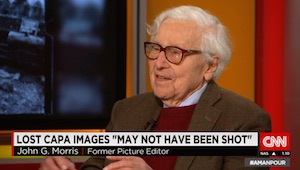
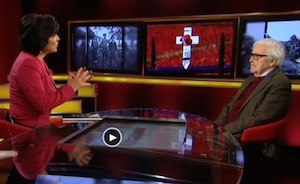
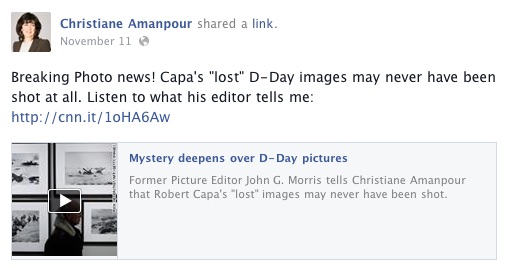
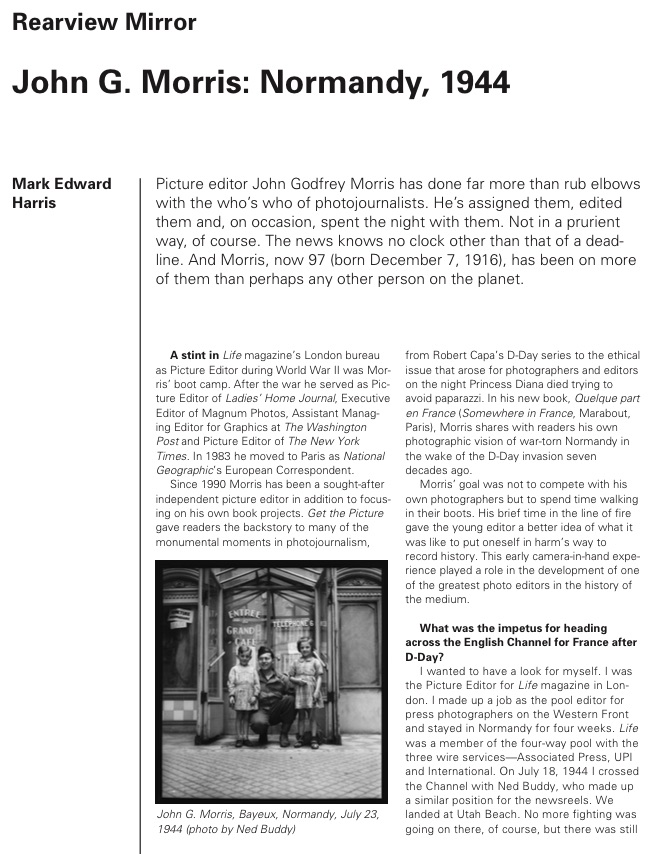
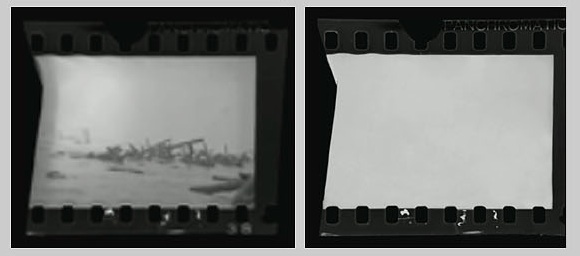
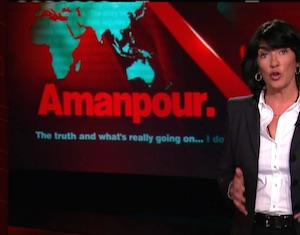
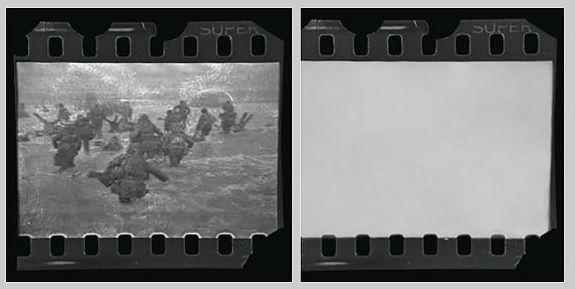
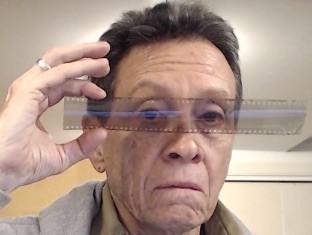

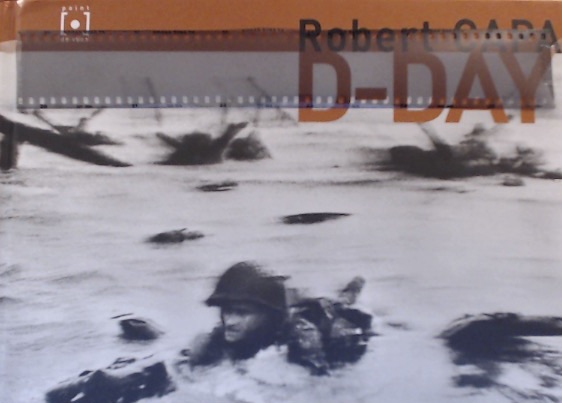




This article on time.com seems apposite for this ongoing John Morris issue: “Why 40% of Americans Misremember Their 9/11 Experience.”
Thanks for pointing me to this. Certainly memory can be unreliable, and can change over time. But that doesn’t explain this particular situation. In interviews and essays published over a 70-year period, John Morris told his version of the supposed loss of Capa’s D-Day negatives due to a darkroom accident virtually word for word, dozens and probably hundreds of times. I can detect in all those versions prior to this investigation only one change: the introduction of photographer Hans Wild as present in the darkroom that night and presumably a witness to what happened. Conveniently, Wild entered Morris’s account only after his death, when he could no longer corroborate or impeach it.
That Morris, faced with undeniable documentation contradicting his original story, now scrambles for some alternative narrative that would leave him unembarrassed, has little to do with memory, in my opinion, but everything to do with ego.